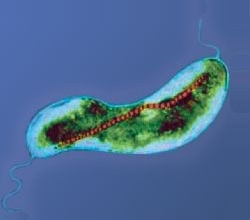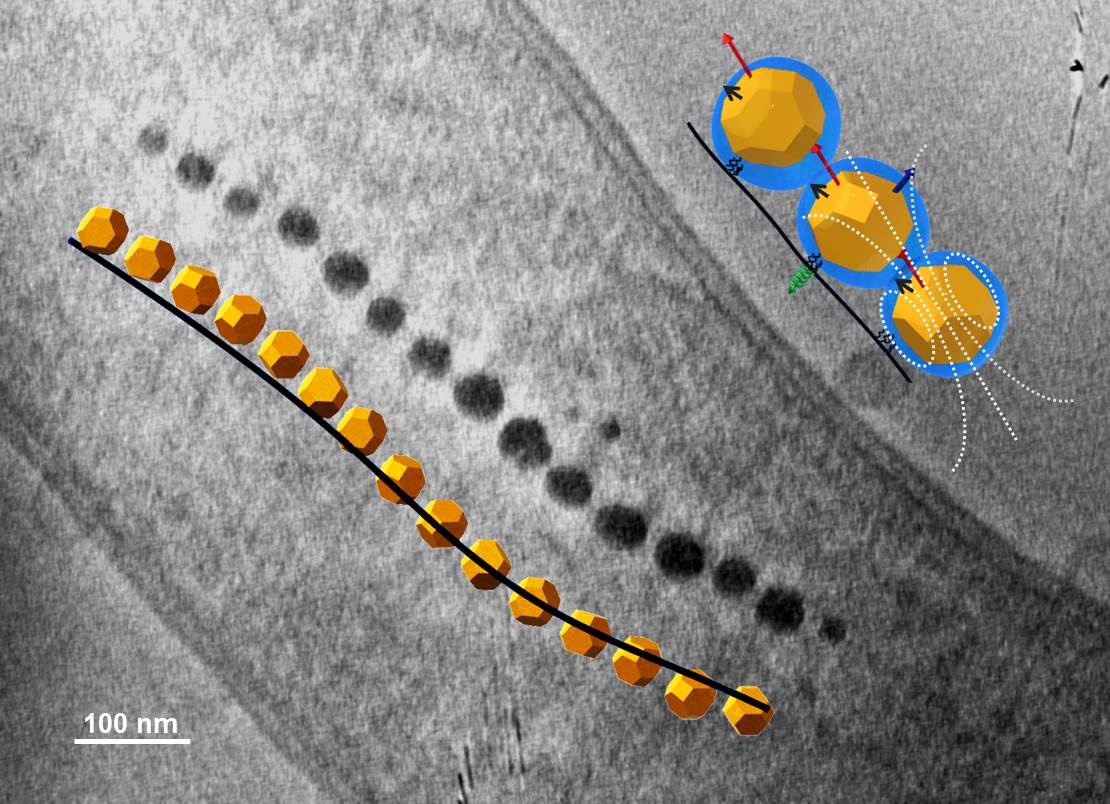Insights into magnetic bacteria may guide research into medical nanorobots Understand article
This article was originally published on ILL News.
Beyond the five senses: Some bacteria can sense magnetic fields. Learn how they do this and how this could help us design nanorobots.

magnetotactic bacterium,
with the magnetosome
shown in orange.
Image: Various. CC BY-SA 3.0
Magnetotactic bacteria (MTB) are widespread aquatic microorganisms that have the ability to orientate themselves to magnetic fields. MTB exercise their magnetic navigation skills using magnetosomes, which are composed of membrane-enclosed magnetic nanoparticles that MTB naturally biomineralise. These nanoparticles are arranged in a chain that acts like a magnetic compass, allowing the bacteria to move within chemically and redox stratified sediments and water columns to satisfy their nutritional requirements by using the Earth’s magnetic field. This unusual behaviour makes them a subject of interest for improving our understanding of biomagnetism, and potentially harnessing their abilities for future technologies, such as medical nanorobots.
An international collaboration of researchers from University of the Basque Country, University of Cantabria and the Institut Laue Langevin (ILL) studied the precise arrangement and geometry of the magnetosomes in the MTB strain Magnetospirillum gryphiswaldense. Small angle neutron scattering (SANS) was carried out with an instrument that has a polarised neutron beam mode, which allowed the researchers to analyse both the structural components and magnetic arrangement – possible because neutrons will interact with both. Magnetosomes and magnetotactic bacteria are great candidates for many applications, ranging from biomedical diagnostics to hyperthermia cancer treatments. Determining the magnetic configuration of the magnetosome chain is of paramount importance for any future applications; however, it is challenging to probe directly. Neutron-spin resolved (or ‘polarised’) small-angle neutron scattering is one of the few tools that can be used to investigate nanoparticles on the relevant scale.

©ILL
Using SANS, the researchers gained new insight into the structure of the magnetosome chain, which had previously been shown to be bent. Neutron probing revealed that the bends do not affect the direction of the net magnetic moment but do cause the individual nanoparticle magnetic moment to deviate by 20 degrees from the chain axis. Once the deviation is taken into account, the interplay of magnetic dipolar interactions between the nanoparticles, together with active assembly by the bacterial proteins, explain the conformation of the chains in a helical-like shape: it is simply the lowest-energy arrangement.
These findings, published in the journal Nanoscale, facilitate a better understanding of how the chain behaviour might affect applications of MTB. This could guide the development of biological nanorobots, which may deliver drugs or perform minor surgery inside the body. The magnetosome chain of the bacteria could provide directional motion within the steering system. In this case, the conformation of the chain would be critical for it to function correctly and navigate around the body. Nanorobots would enable minimally invasive medical procedures to be carried out, relieving patients of the trauma caused by intrusive surgery.
Dirk Honecker, scientist at the ILL at the time of the experiment and now at ISIS Neutron and Muon Source, said: “Neutron scattering is a valuable tool for examining these magnetosomes and also other materials in great detail. Our small-angle neutron instrument D33 with its polarised beam capability allows us to analyse the magnetic interactions as well as the nanoscale structures, thanks to the magnetic moment of neutrons. With this new information, we are taking a step closer to harnessing the potential of these amazing nanostructures produced by nature. Amongst the most exciting applications will be those involving medicine – the tiny compass in the bacteria might be used to navigate the human body, and guide nanorobots to carry out tasks in specific organs or limbs.”
References
- Orue I et al. (2018) Configuration of the magnetosome chain: a natural magnetic nanoarchitecture. Nanoscale,10: 7407-7419 doi: 10.1039/c7nr08493e
Resources
- Watch a funny video about magnetotactic bacteria.
- Learn more about magnetotactic bacteria watch this video.
- Read a Teach article with nanoexperiments for the classroom.
- Learn about how magnetic fields can help in the recycling of detergents.
- Thermophilic microorganisms live in extremely hot conditions; read about their use in biotechnology.





